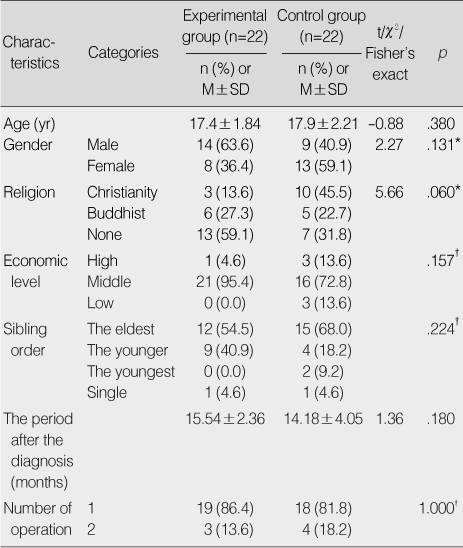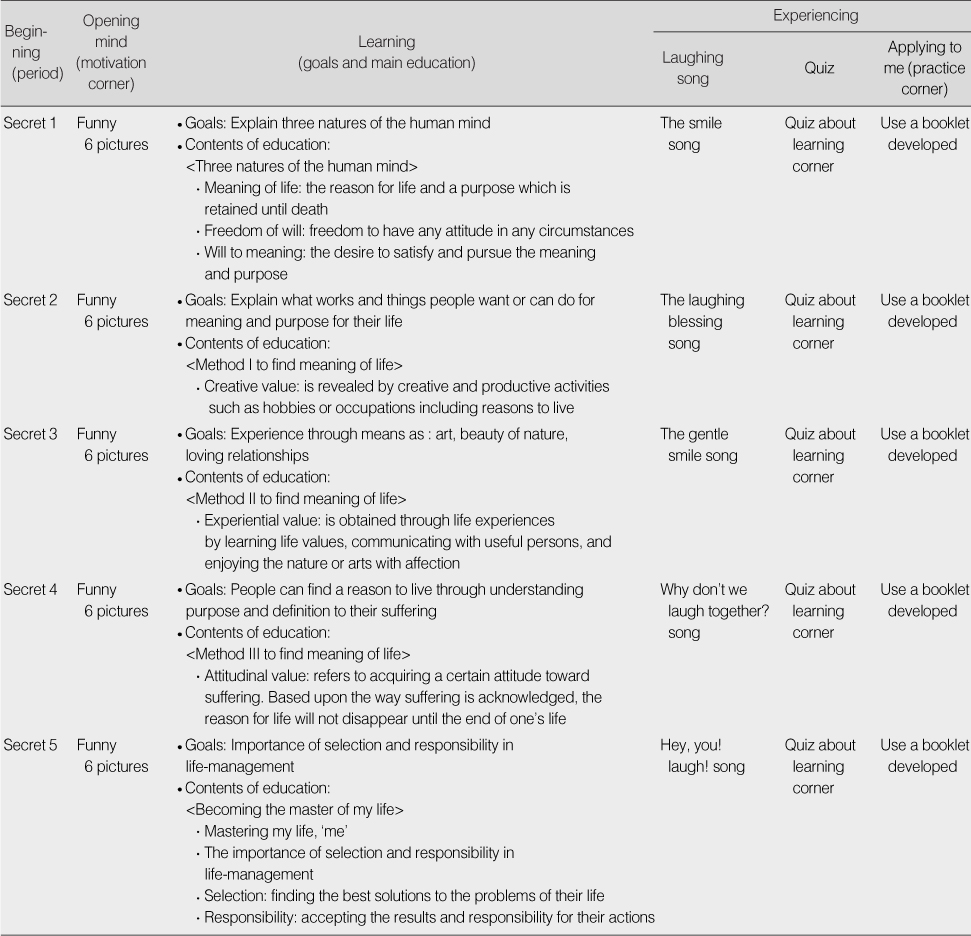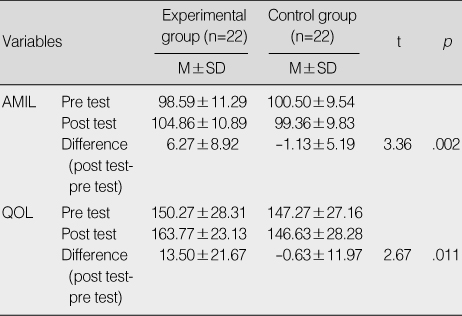Articles
- Page Path
- HOME > J Korean Acad Nurs > Volume 39(6); 2009 > Article
-
Original Article
- The Effects of Logotherapy on Meaning in Life and Quality of Life of Late Adolescents with Terminal Cancer
- Kyung-Ah Kang, Jeoung-Sook Shim, Dae-Geun Jeon, Myung-Suk Koh
-
Journal of Korean Academy of Nursing 2009;39(6):759-768.
DOI: https://doi.org/10.4040/jkan.2009.39.6.759
Published online: December 31, 2009
1Professor, Department of Nursing, Sahmyook University, Seoul, Korea.
2Head Nurse, Korea Cancer Center Hospital, Seoul, Korea.
3MD, Department of Orthopedic Surgery, Korea Cancer Center Hospital, Seoul, Korea.
4Associate Professor, Department of Nursing, Sahmyook University, Seoul, Korea.
- Address reprint requests to: Kang, Kyung-Ah. Department of Nursing, Sahmyook University, 26-21 Gongneung-dong, Nowon-gu, Seoul 139-742, Korea. Tel: 82-2-3399-1585, Fax: 82-2-3399-1594, kangka@syu.ac.kr
Copyright © 2009 Korean Society of Nursing Science
Abstract
-
Purpose
- To evaluate the effects of a logotherapy program entitled 'Finding meaning in my life' for adolescents with terminal cancer.
-
Methods
- A nonequivalent control group, non-synchronized design was conducted with a convenience sample of 44 late adolescents with terminal cancer. The experimental group (n=22) participated in the 'Finding meaning in my life' program which consisted of five-day sessions for one week. The control group (n=22) received the usual nursing care. The effects were measured using adolescent meaning in life (AMIL), and quality of life (QOL) scales. The collected data were analyzed by descriptive statistics, Chi-square, and t-test using SPSS/PC 17.0 program.
-
Results
- There were significant differences in AMIL (t=3.36, p<.05) and QOL (t=2.67, p<.05) between the experimental and control groups.
-
Conclusion
- Logotherapy is effective in improving the meaning in life and quality of life of late adolescents with terminal cancer, and can be used to prevent existential distress.
This work was supported by the Korea Research Foundation Grant funded by the Korean Government (MOEHRD) (KRF-2006-311-E00562).
- 1. Brallier LW. Starck PL, McGovern JP. The suffering of terminal illness : Cancer. In: The hidden dimension of illness human suffering. 1992;New York, NY, NLN. 203–225.
- 2. Cho HS. The effects of logotherapeutic group counseling on purpose in life, self-concept, self-esteem and spiritual wellbeing of adolescence. 2000;Busan, Kosin University. Unpublished master's thesis.
- 3. Choi MO. The effects of logotherapy group counseling on the purpose in life and a life of faith of christian teenager. 2000;Daegu, Keimyung University. Unpublished master's thesis.
- 4. Choi SO, Kim SN, Shin KI, Lee JJ. Development of meaning in life scale II. Journal of Korean Academy of Nursing. 2005;35:931–942.ArticlePubMedPDF
- 5. Cohen J. Statistical power analysis for the behavioral science. 1988;2nd ed.Hillsdale, NJ, Lawrence Eribaum Associates.
- 6. Crumbauch JC, Maholick LJ. Manual of instructions for the purpose in life test. 1964;Munster, Psychometric Affiliates.
- 7. Dunbar GC, Stoker MJ, Hodges TC, Beaumont G. The development of SBQOL-A unique scale for measuring quality of life. British Journal of Medical Economy. 1992;2:65–74.
- 8. Fochtman D. The concept of suffering in children and adolescents with cancer. Journal of Pediatric Oncology Nursing. 2006;23:92–102.ArticlePubMedPDF
- 9. Frankl VE. Man's search for meaning. 1963;New York, NY, Washington Square Press.
- 10. Frankl VE. The will to meaning: Foundations and applications of logotherapy. 1988;New York, NY, Penguin.
- 11. Gove PB. Webster's third new international dictionary of the English language. 1984;3rd ed.Springfield, MA, Merriam-Webster Inc.
- 12. Han SC, Jo AM, Park SH. The psychology of adolescent. 2004;Seoul, Yangsuewon.
- 13. Jun MH, Uhm DC, Jeong SH. The analysis of the Korean nursing research trends on complementary and alternative therapies for cancer patients. Journal of Korean Oncology Nursing. 2009;9:67–75.
- 14. Kang KA, Im JI, Kim HS, Kim SJ, Song MK, Sim SY. The effect of logotherapy on the suffering, finding meaning, and spiritual well-being of adolescents with terminal cancer. Journal of Korean Academy of Child Health Nursing. 2009;15:136–144.Article
- 15. Kang KA, Kim SJ, Lyu CJ, You YG, Song MK. Development of a CD program applied logotherapy to promote quality of life in adolescents with terminal cancer. Journal of Korean Academy of Child Health Nursing. 2007;13:495–505.
- 16. Kang KA, Kim SJ, Song MK. CD program development applied logotherapy to improve quality of life of older school-age children with terminal cancer. The Korean Journal of Hospice and Palliative Care. 2008;11:82–90.
- 17. Kang KA, Kim SJ, Song MK. Development of a CD program applied logotherapy for psycho·spiritual care of late adolescents with terminal cancer. The Korean Journal of Hospice and Palliative Care. 2009;12:61–71.Article
- 18. Kang KA, Kim SJ, Song MK, Sim SY. Reliability and validity of an instrument for adolescents meaning in life scale (AMIL). Journal of Korean Academy of Nursing. 2007;37:625–634.ArticlePubMedPDF
- 19. Kim HS, Kang KA, Kim SA, Kim SJ, Kim HS, Kim HO, et al. Child health nursing. 2006;Seoul, KoonJa Publishing Co.
- 20. Kim YH. The effects of group counseling based on logotherapy on the level of the purpose in life, the self-esteem and the decreasing of the stress of unmarried females in their twenties. 1995;Busan, Dong-A University. Unpublished master's thesis.
- 21. Korea National Statistical Office. Korea statistical yearbook. 2007;Seoul, Author.
- 22. Lee SO. The effect of logotherapy group counseling on female adolescent workers' job satisfaction. 1997;Daegu, Keimyung University. Unpublished master's thesis.
- 23. Moon YL, Hwang AR, Choi HS, Park HR, Moon DH, Kim SJ, et al. Hospice care for children. 2004;Seoul, Kunja Publishing Co..
- 24. Oh PJ. An integrative review of oncology nursing research in Korea: 1998-2003. Journal of Korean Oncology Nursing. 2003;3:112–121.
- 25. Park JK, Park CL, Kim NK. Oncology. 2003;Seoul, Iljogak Publishing Co..
- 26. Ro YJ. An analytical study of the quality of life of the middle-aged in Seoul. 1988;Seoul, Yonsei University. Unpublished doctoral dissertation.
- 27. Shim KJ. The effects of logotherapy group counseling in the level of the purpose in life of vocational high school students. 2001;Suncheon, Sunchon National University. Unpublished master's thesis.
- 28. Son SY, Oh KS. Self-image of adolescents with cancer. Journal of Korean Academy of Child Health Nursing. 2005;11:465–471.
- 29. Woodgate RL, Degner LF, Yanofsky R. A different perspective to approaching cancer symptoms in children. Journal of Pain and Symptom Management. 2003;26:800–817.ArticlePubMed
- 30. Yoon JS, Kook SH, Lee MS. A preliminary study on Korean version of the Smithkline Beecham 'quality of life' scale (KvSBQOL). Journal of the Korean Neuropsychiatric Association. 1998;37:280–294.
REFERENCES


Figure & Data
REFERENCES
Citations

- Design and effectiveness of an online group logotherapy intervention on the mental health of Iranian international students in European countries during the COVID-19 pandemic
Shirin Rahgozar, Lydia Giménez-Llort
Frontiers in Psychiatry.2024;[Epub] CrossRef - Effect of a Logotherapy-Based Empowerment Program for Achieving Self-Reliance Among Persons Living Houseless
Myungsun Hyun, Soyoung Kim, Eunyoung Park
Issues in Mental Health Nursing.2024; 45(12): 1301. CrossRef - Assessing meaning in life for gifted learners: Validation of a Chinese version of meaning in life in children questionnaire
Mantak Yuen, Ryder T. H. Chan, Jiahong Zhang, Eric Fung, Serene Chan
Gifted and Talented International.2023; 38(1): 1. CrossRef - Meaning in life as an armor to prevent psychological damage in future crises
Seyyed Muhammad Mahdi Mahdavinoor, Seyyed Hatm Mahdavinoor
Asian Journal of Psychiatry.2023; 80: 103362. CrossRef - Effects of short-term existential group therapy for breast Cancer patients
Chizu Nakamura, Masatoshi Kawase
BioPsychoSocial Medicine.2021;[Epub] CrossRef - Meaning-Centered Interventions for Patients With Advanced or Terminal Cancer
Kyung-Ah Kang, Suk-Jung Han, Young-Sook Lim, Shin-Jeong Kim
Cancer Nursing.2019; 42(4): 332. CrossRef - The effects of psychological meaning-centered therapies on quality of life and psychological stress: A metaanalysis
Joël Vos, Diego Vitali
Palliative and Supportive Care.2018; 16(5): 608. CrossRef - Systematic Review of Meaning-centered Interventions for Adolescents
Young Sook Lim, Kyung A Kang
Child Health Nursing Research.2018; 24(3): 263. CrossRef - Models for Spiritual Care in Hospice and Palliative Care
Kyung-Ah Kang
The Korean Journal of Hospice and Palliative Care.2018; 21(2): 41. CrossRef - An Integrative Review of Meaning-Centered Intervention Studies for Patients with Advanced or Terminal Cancer
Kyung Ah Kang, Suk Jung Han, Shin Jung Kim, Young Sook Lim
Asian Oncology Nursing.2018; 18(4): 173. CrossRef - State of the Science of Spirituality and Palliative Care Research Part II: Screening, Assessment, and Interventions
Tracy A. Balboni, George Fitchett, George F. Handzo, Kimberly S. Johnson, Harold G. Koenig, Kenneth I. Pargament, Christina M. Puchalski, Shane Sinclair, Elizabeth J. Taylor, Karen E. Steinhauser
Journal of Pain and Symptom Management.2017; 54(3): 441. CrossRef - Effects of Logotherapy on Life Respect, Meaning of Life, and Depression of Older School-age Children
Kyung-Ah Kang, Shin-Jeong Kim, Mi-Kyung Song, Mi-Jeong Kim
Journal of Korean Academy of Nursing.2013; 43(1): 91. CrossRef - The Effects of Logotherapy on Meaning of Life of Early Adolescents with Cancer
Shin-Jeong Kim, Kyung-Ah Kang, Sun-Jeong Park, Myung-Nam Lee, Young-Hee Kim
Asian Oncology Nursing.2013; 13(1): 49. CrossRef - Adaptation to Physical Disabilities: The Role of Meaning in Life and Depression
Evangelia Psarra, George Kleftaras
The European Journal of Counselling Psychology.2013; 2(1): 79. CrossRef - Meaning in Life, Psychological Well-Being and Depressive Symptomatology: A Comparative Study
George Kleftaras, Evangelia Psarra
Psychology.2012; 03(04): 337. CrossRef - Spirituality, Meaning in Life, and Depressive Symptomatology in Individuals with Alcohol Dependence
George Kleftaras, Irene Katsogianni
Journal of Spirituality in Mental Health.2012; 14(4): 268. CrossRef

Figure 1
Contents of the Logotherapy Program for Late Adolescents with Terminal Cancer
Homogeneity of General and Diagnostic Characteristics between Experimental and Control Group (N=44)
*χ2 test; †Fisher's exact test.
Homogeneity of Dependent Variables between Experimental and Control Group (N=44)
AMIL=adolescents meaning in life; QOL=quality of life.
Mean Difference Comparisons of AMIL and QOL between Experimental and Control Group (N=44)
AMIL=adolescents meaning in life; QOL=quality of life.
*χ2 test; †Fisher's exact test.
AMIL=adolescents meaning in life; QOL=quality of life.
AMIL=adolescents meaning in life; QOL=quality of life.
 KSNS
KSNS
 E-SUBMISSION
E-SUBMISSION



 Cite
Cite

